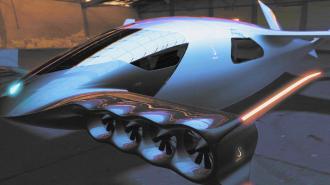Swiss startup Sirius Aviation has unveiled what it says is the world’s first hydrogen VTOL (vertical take off and landing) aircraft — and an ambitious plan to have it in the air by 2025.
The challenge: Electric VTOLs (eVTOLs) are widely promoted as the next big thing in aviation, and dozens of companies developing their own versions of the vehicles — fleets of flying electric taxis planned to zip around cities and over traffic jams.
Like helicopters, eVTOLs can lift off and land without a runway, which means they can operate without airports or runways.
Unlike helicopters, eVTOLs are powered by electricity — this makes them quieter and more climate friendly, but the weight and limited energy density of their batteries means they also can’t fly as far.
Hydrogen VTOL: In an attempt to set itself apart from the pack, Sirius has designed its emissions-free VTOL, the Sirius Jet, to be powered by liquid hydrogen.
The jet’s propulsion system combines this hydrogen with oxygen, pulled in from the outside air, to generate the electricity needed to power it — the only byproduct of this process is water.
The details: Sirius has unveiled two versions of its hydrogen VTOL — the Sirius Millennium Jet and the Sirius Business Jet — which it designed in collaboration with BMW’s Designworks and Sauber Group, an engineering company known for its Formula 1 cars.
The Millennium has room for five passengers and a pilot, and its flight range of 650 miles is more than enough to get you from Washington, DC to Chicago. The Sirius Business Jet, meanwhile, has room for three passengers and a pilot and a range of 1,150 miles — that’s enough for a trip between New York and Miami. Both have a cruise speed of 323 mph.
Because the energy density of the liquid hydrogen system is greater than that of lithium-ion batteries, Sirius’ range and speed is much greater than that of comparable eVTOLs.
Toyota-backed Joby Aviation’s in-development eVTOL, for example, has a range of 150 miles and a top speed of 200 mph. An eVTOL made by Archer Aviation — a partner of United Airlines — maxes out at 100 miles and 150 mph. Both carry four passengers and a pilot.
The cold water: The big difference between Sirius’s hydrogen VTOL and those eVTOLs is that they’ve actually proven capable of flight — Joby’s prototype has racked up nearly 25,000 miles in the air, in fact.
The FAA has also certified at least one eVTOL and one hydrogen plane as “airworthy” — Alef Aeronautics’ Armada Model Zero and Universal Hydrogen’s Dash 8-300, respectively — but since Sirius’ hydrogen VTOL is the first aircraft of its kind, there’s no precedent for certification. That could potentially make it more time-consuming to get through the regulatory process.
Liquid hydrogen is also a quite novel fuel source for aircraft. Most in-development hydrogen planes store the fuel in a gaseous form — the first piloted flight of a plane fueled by liquid hydrogen only just took place, in September 2023.
“We have funds, but not enough to do this fast.”
Alexey Popov
Looking ahead: Despite those challenges, Sirius has laid out an incredibly ambitious timeline for its jets, with the first test flights planned for 2025, followed by certification in 2026 and the launch of commercial services in 2028.
Sirius’ ability to secure funding will likely determine whether it has any chance of hitting those milestones — the startup has been funded internally to date, but is now looking for outside investors.
“We have funds, but not enough to do this fast,” CEO Alexey Popov told Aviation Week. “And the market is hot, so we want to move fast.”
We’d love to hear from you! If you have a comment about this article or if you have a tip for a future Freethink story, please email us at tips@freethink.com.
